How to Cite a Website in MLA: A Complete Guide
A Step by Step Guide: How to Cite a Website in MLA 8
If you are a student faced with creating an MLA website citation for the first time, you may be confused about where to begin. This guide is here to answer all of your questions and take the guesswork out of creating an MLA citation for websites.
All academic fields require students and researchers to document their sources. Those studying the humanities, including fields in language literature, will typically follow MLA format when structuring their papers as well as when documenting sources.
MLA 8 Citations for Websites
Students who have created an MLA citation for a website using previous versions of their handbook may recall that each source’s publication format determined which elements were to be included in its Works Cited entry. The eighth edition has shifted focus and offers universal guidelines for all citations regardless of the source’s publication medium.
The Modern Language Association refers to these guidelines as “The Core Elements” on page 20 of the Handbook If your teacher has asked you to cite your sources in this format, these elements will form the foundation for each MLA website citation included in your MLA Works Cited list, as well as the entries for sources in any other format.
- Author.
- Title of source.
- Title of the container,
- Other contributors (names and roles),
- Version,
- Number,
- Publisher,
- Publication Date,
- Location of the source (such as URL or page range).
If one of the elements does not apply, students may omit it. Optional items may also be included when necessary. In addition to the optional details discussed below, a list of additional optional components can be found on the MLA website.
To learn more about the Modern Language Association and find additional resources for students, read about the style in the news or check out this site for additional information.
If it’s an APA citation website page or an APA works cited page you need help with, we have many other resources available for you!
Changes to MLA Citation for Websites in Eighth Edition
Previously, students and researchers creating an MLA website citation were not required to include the URL. When creating an MLA 8 citation for a website, however, it is recommended that you include the URL unless your teacher instructs you otherwise. Even though web pages and URLs can be taken down or changed, it is still possible to learn about the source from the information seen in the URL.
When including URLs in a citation, http:// and https:// should be omitted from the website’s address (Handbook 48). Additionally, If you are creating a citation that will be read on a digital device, it is helpful to make the URL clickable so that readers can directly access the source themselves.
If the website’s publisher includes a permalink or DOI (Digital Object Identifier), these are preferable as they are not changeable in the same manner as URLs. Whether you include a URL, permalink, or DOI, this information should be included in the location portion of your citation.
Another change with the eighth edition that impacts how to cite a website in MLA is the removal of the date the website was accessed. While you may still find it useful to include this information or your teacher may request it, it is no longer a mandatory piece of your citation. Should you choose to add this optional information, you may list it after the URL in the following manner:
- Accessed Day Month Year.
- 2 May 1998.
- 31 Apr. 2001.
- 17 Sept. 2010.
For an overview of additional formatting changes in the eighth edition, including resources to help with writing an annotated bibliography, check out the rest of EasyBib.com’s writing and citation guides, and try out our plagiarism checker for help with grammar and to avoid unintentional plagiarism.
MLA 8: Citing Websites With an Author
To make an MLA 8 citation for a website, you will need the following pieces of information:
- author’s name
- title of the article or page
- title of the website
- name of the publisher (Note: Only include the name of the publisher when it differs from the name of the website.)
- date the page or site was published (if available)
- URL
Websites with one author:
Place the author’s name in reverse order, the last name first, followed by a comma, and then the first name followed by a period. The title of the web page or article is placed in quotation marks, with a period before the end quotation. The title of the website is written in italics followed by a comma. If the name of the publisher differs from the name of the website, include it after the title. Immediately following the publisher is the date that the page or article was published, or posted. Finally, end with the URL, permalink, or DOI.
Author’s Last name, First name. “Title of the Article or Individual Page.” Title of the Website, Name of the Publisher, Date of Publication in Day Month Year format, URL.
McNary, Dave. “Keanu Reeves, Alex Winter Returning for ‘Bill and Ted Face the Music.’” Variety, Penske Media Corporation, 8 May 2018, variety.com/2018/film/news/bill-and-ted-3-keanu-reeves-alex-winter-1202802946/.
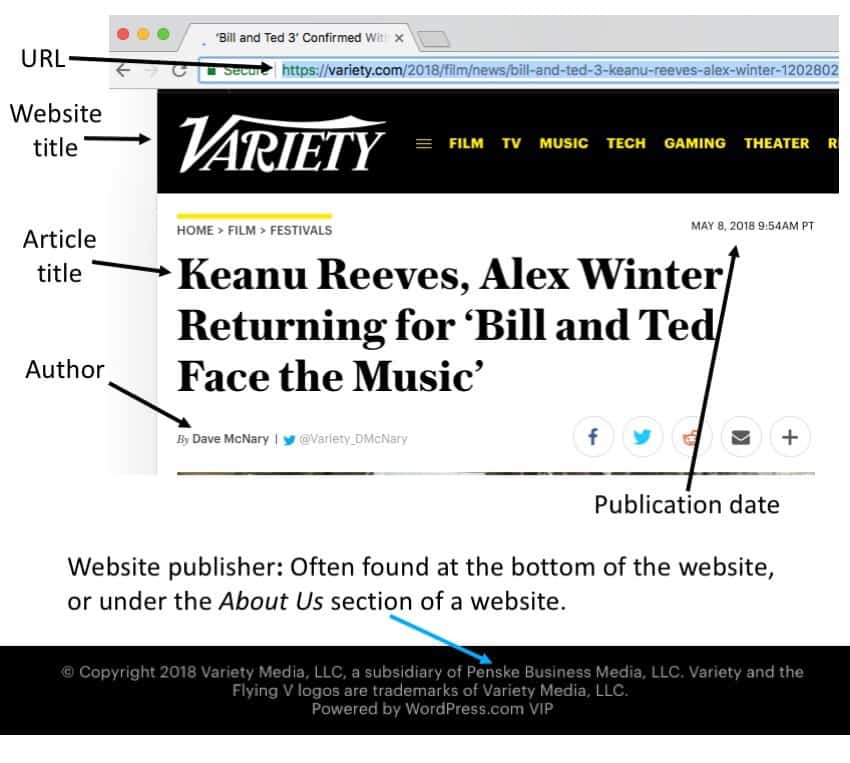
In-text citation, one author
The in-text citation for a website with an author is reflected as the author’s last name in parentheses, followed by a period. Unless the website includes numbered paragraphs or sections, you should not include any additional information. For the website used in the example above, the in-text citation would be written as follows:
- (McNary).
An APA parenthetical citation is similar, except it also includes the year the source was published.
To learn more about formatting an MLA in-text & parenthetical citations, be sure to check out the rest of EasyBib.com’s resources and citation guides.
Websites with two authors:
According to Section 2.7.3 of the Handbook, for a website with two authors, place the authors’ names in the same order as the source (similar to an APA citation). The first name should be formatted in reverse order as was done for a single author. The second name, however, is written as First Name Last Name and is followed by a period, as demonstrated in the template that follows:
Last name, First name of Author 1, and First Name Last Name of Author 2. “Title of Web Page.” Title of Website, Publisher, Date Published in Day Month Year format, URL.
Wadhwa, Vivek, and Alex Salkever. “How Can We Make Technology Healthier for Humans?” Wired, Condé Nast, 26 June 2018, www.wired.com/story/healther-technology-for-humans/.
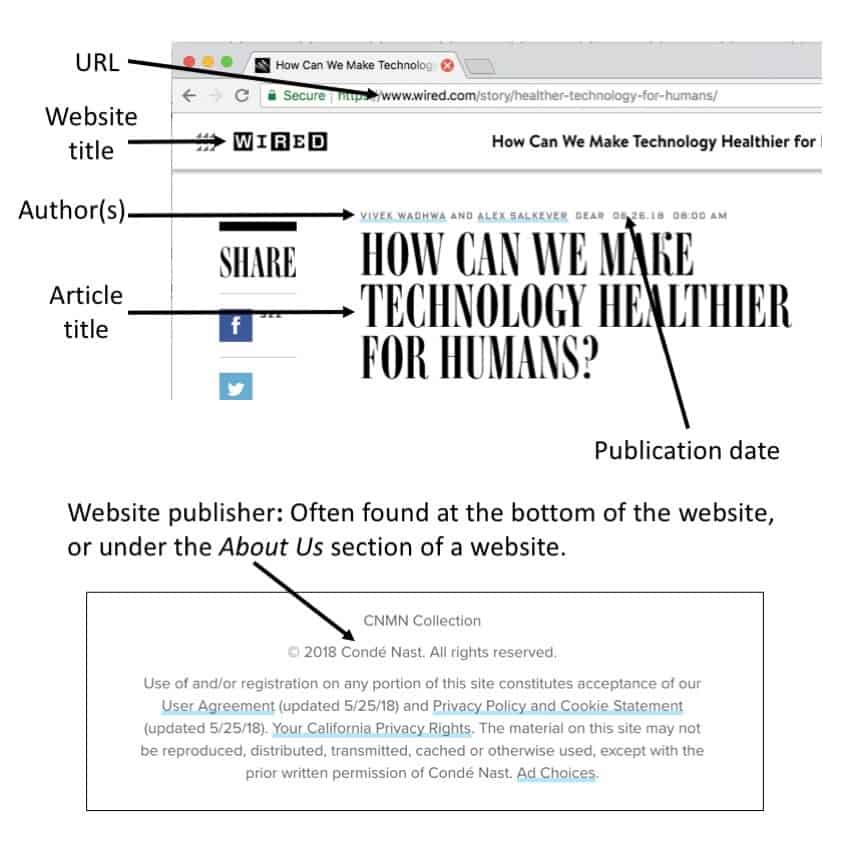
In-text citation, two authors
The in-text citation for a website with two authors should include both authors’ last names, in the order in which they are listed in the source and your works cited:
- (Wadhwa and Salkever).
Website with three or more authors:
For a source with three or more authors, you should place the authors’ names in the same order as the source. The first name is listed in reverse order and is followed by a comma and et al. Et al is the abbreviation for et alia, a gender-neutral Latin phrase meaning “and others.”
First listed author’s Last name, First name, et al. “Title of Web Page.” Title of Website, Publisher, Date published in Day Month Year format, URL.
In-text citation, 3+ authors
The in-text citation for a website with three or more authors should contain only the first author’s last name, followed by et al. (Handbook 116):
- (Last Name 1 et al.).
Click on this page if you’re looking for information on how to create an APA in-text citation.
MLA 8 Citation for Websites with No Author
Sometimes, websites do not state who wrote the information on the page. When no author is listed, you may omit the author information from the MLA citation for the website and begin, instead, with the title (Handbook 24).
How to cite a website with no author in MLA 8:
“Title of Web Page.” Title of Website, Publisher, Date published in Day Month Year format, URL.
“One Health and Disease: Tick-Borne.” National Park Service, U.S. Department of the Interior, https://www.nps.gov/articles/one-health-disease-ticks-borne.htm.
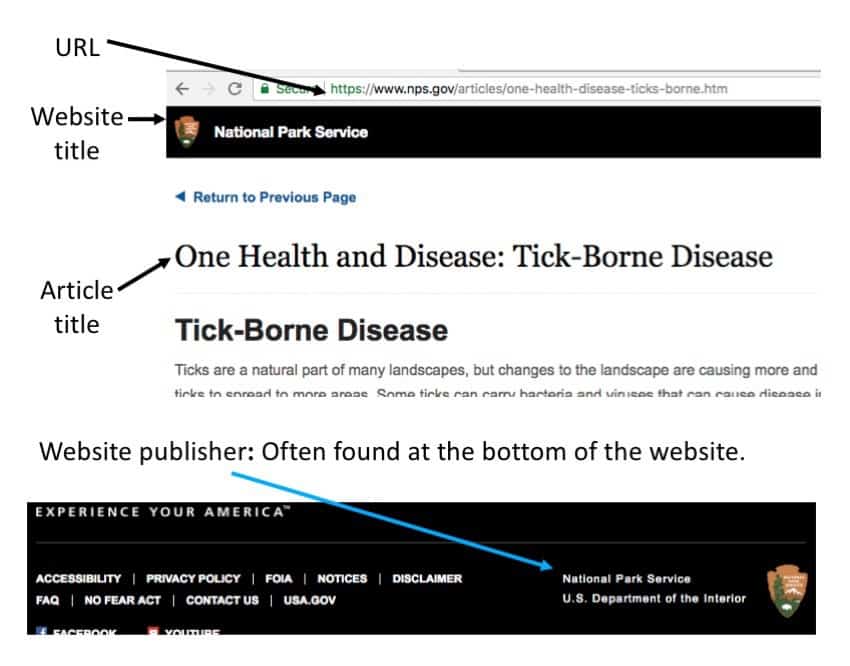
Note about web pages by organizations/corporations
Often, web pages are published by organizations or corporations with no author indicated. In these cases, you can assume that the publisher also authored the web page (like the example above). Since the author and publisher are the same in these cases, you can skip showing an author and just indicate the organization/corporation as the publisher (Handbook 25).
In-text citation, no author
The in-text citation for a website without an author is noted with the first word or words in the title in parentheses, followed by a period. Unless the website includes numbered paragraphs or sections, you should not include any additional information. For the website used in the example above, the in-text citation would be written as:
- (One Health and Disease)
How to Cite a Website in MLA 8 Without a Formal Title
When citing a web page that does not include a formal title, it is acceptable to include a description of the page. Do not place the description in italics or quotation marks. Follow the description with the name of the website.
General Information on the New York Mets. NYCData, The Weissman Center for International Business Baruch College/CUNY, www.baruch.cuny.edu/nycdata/sports/nymets.htm.
MLA 8 Website Citation: Social Media
In an increasingly digital world, social media platforms have become one of the most popular sources students turn to when writing a research paper. From Black history facts, to quotes from notable people, such as Martin Luther King and Winston Churchill, social media has become a mega influence in our world.
When citing social media in your work, follow the same format as an MLA citation for a website. Here are some examples of ways you can cite various social media platforms in your work:
Many notable individuals use Twitter as a platform to share intriguing ideas. It’s a shame Twitter was unavailable to long-gone scientists, authors, and presidents such as Albert Einstein, Mark Twain, and Abraham Lincoln. Luckily, we have the Twitter profiles of today’s great minds at our fingertips!
To cite a tweet, you will begin with the account holder’s Twitter handle, followed by a period (Handbook 24). After this, in quotations, you should enter the full text of the tweet, including any hashtags. The publisher, Twitter, is then listed in italics, followed by the date in Day, Month, Year format and the time the tweet was posted. Finally, include a URL to the tweet followed by a period.
@TwitterHandle. “Content of Tweet.” Twitter, Day Month Year, Time stamp, URL.
@Lin_Manuel. “Gmorning from a sky still blue above the smoke from a world still full of love and hope beyond the headlines from your own best self, whispering, ‘I’m still here, and it’s never too late to put me to work.’” Twitter, 22 June 2018, 7:21 a.m., twitter.com/Lin_Manuel/status/1010165965378719745.
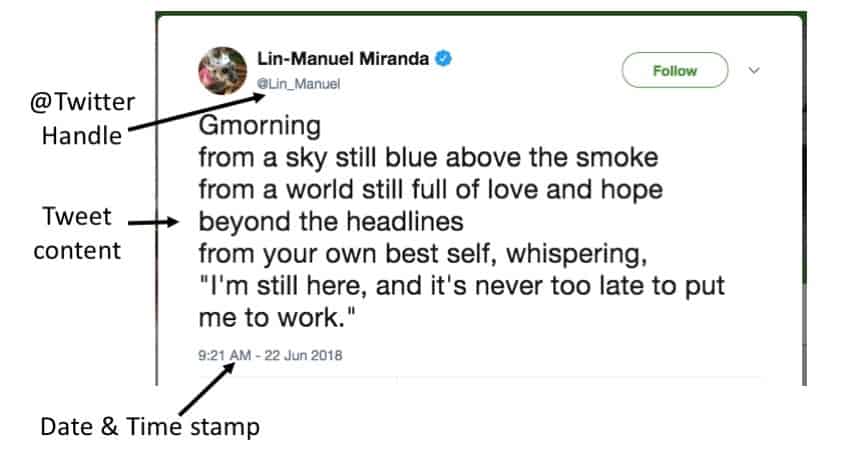
To cite an Instagram post, begin with the account holder’s name or username. In quotations, list the title of the photo, if it is given. If there is no title, write a brief description of the picture but do not place it in italics or quotation marks. The publisher, Instagram, is then listed in italics. Any other contributors (such as the photographer, if it is not the same as the account holder) are then listed, after which you will add the date and URL.
Account holder’s username. “Photo Title” or Description*. Instagram, Other contributors, Date photo was published in Day Month Year format, URL.
*If no title is available, create a simple description and do not place it in italics or quotation marks.
Examples:
@natgeo. “Path of the Panther.” Instagram, photographed by Carlton Ward, 16 June 2018, www.instagram.com/p/BkFfT9xD6h6/?taken-by=natgeo.
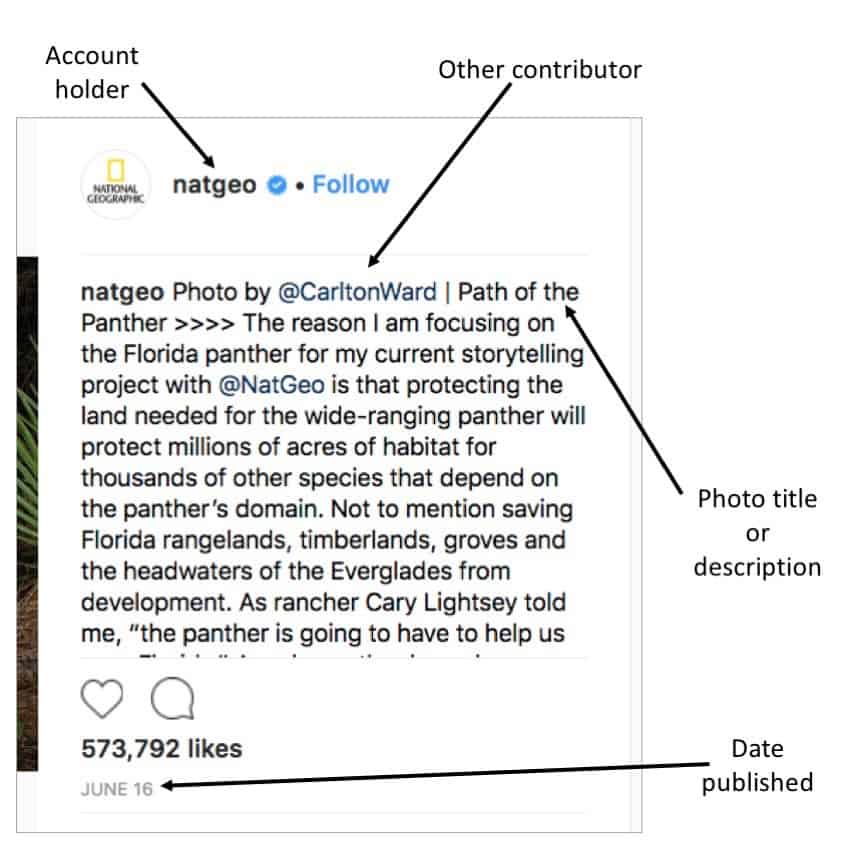
To cite a Facebook post, begin with the account holder’s name or username. In quotations, list the title or caption of the post, if it is given. If there is no title or caption, write a brief description of the post but do not place it in italics or quotation marks.
Examples: Image of Malcolm X, or, Muhammed Ali headshot.
The publisher, Facebook, is then listed in italics, after which you will add the date, time posted, and URL.
Author Last Name, First Name or Account Name. Description of Post. Facebook, Day Month Year of Post, Time Stamp, URL. (Optional) Accessed Day Month Year.
GoatsofAnarchy. Loner Goats Become Stallmates and Fall in Love. Facebook, 25 June 2018, 9:55 p.m., www.facebook.com/thegoatsofanarchy/posts/2103455423030332:0. Accessed 26 June 2018.
Social media and website comments
Citing the comments left on social media or a website begins with the commenter’s name or username. To indicate that you are citing a comment, follow the name with a period and then the words Comment on, followed by the title of the source (for example, the name of the article) in quotation marks. This is then followed by the title of the website in italics, and the publisher, if applicable. The date and time stamp are then listed, followed by the URL, permalink, or DOI.
Use the Username or Commenter’s Name as the author’s name. Comment on “Title.” Publisher, Day Month Year, Time, URL.
Wester, Gary. Comment on “Climate Reality and I are headed to Berlin this June to train leaders who want to help solve the climate crisis.” Facebook, 2 May 2018, www.facebook.com/algore/posts/10155643818533865:0.
In-text Citations for Websites
These generally consist of parentheses and the last names of the authors or the first few words of the web page title.
Since there are no page numbers, unless the web page includes numbered paragraphs or sections, you don’t need to include any additional information.
When you have multiple authors, place them in the same order they are listed in the source.

If what you really need is an APA book citation or a reference for an APA journal, there are more guides on EasyBib.com for you to explore.
Post a Comment